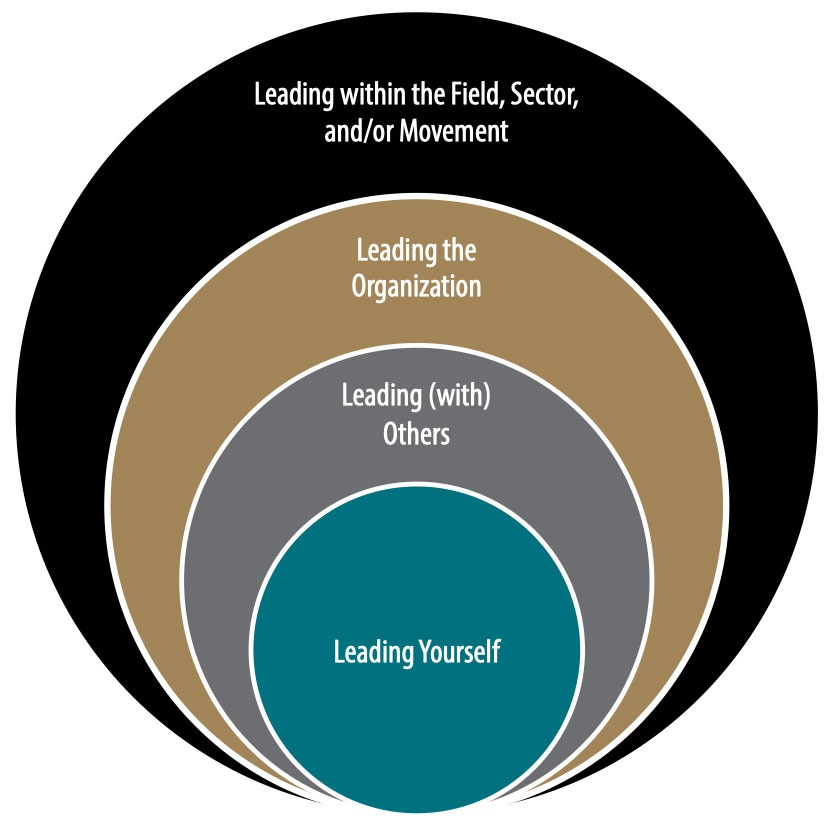
This article is from the Nonprofit Quarterly’s winter 2017 edition, “Advancing Critical Conversations: How to Get There from Here.”
Most of us know from experience that when important conversations about our work get stuck in avoidant and self-referential loops, it delays our ability to advance social issues and even our day-to-day practices in our organizations. This is a well-tested tenet of systems thinking, which also advises us that in their tendency to resist change, systems often throw up false signals that detour and fatally delay change efforts. This requires that we remain attentive to the content of the conversations that are helping us to advance our work, and distinguish them from those that would retard progress. There is, of course, a good deal of literature about how we can understand and implement change, but much of it will reflect the following basic structure: What we have (contrasted against) what we want—and how to get from here to there.
The Tension between What Is and What Can Be
The structure described above is the basic fractal for a change conversation. You surface the issue and explore it—warts and all—taking responsibility for your part in making it less than desirable. You imagine what an ideal state could be, and then you keep iterating the two elements: “what we want” and “how to get there from here”—the here being ever changing. In the midst of all of that, you take into account that others do not always see the same critical notions, dynamics, and assets that we work with, and it will be up to you to hold them as sacred touch points.
It is the tension between what is and what could be that gives energy to a change effort, and that energy must come from people who own and believe in a common vision because they have worked on its development together.
Thus, part of the strength of the civil sector is in our constant and curious voluntary engagement with one another around practice issues in nonprofits and philanthropy. How do we really “know” a thing well enough to ask the next right question about it? Is our vision held in common with others? And who are those others?
When conversations that are meant to advance our work get stuck, it can take years—even decades—to get them moving again. Clearly, no nonprofit can afford that down time right now, when all around us variables like policies, community demographics, funding sources, and people’s expectations of institutions are in tumultuous upheaval. Therefore, the question of how to keep change-oriented conversations moving becomes of utmost importance to this sector, charged as it is with acting in the best interests of those they purport to serve or represent.
Interrupting Conversations to Nowhere
This edition of the Nonprofit Quarterly looks at a few conversations that have been stuck and have just begun to advance again—shared leadership, collective action, and fiscal sponsorship—and at what the dynamics and processes are for initiating and exploring change within the sector. It also looks at what may be blocking the progress of the conversations, making them repetitive, circular, and nonsensical. Other obvious examples are the overhead ratio—which was known to be off base for at least three decades before it was largely shut down (over the past eighteen months or so)—and the ridiculous remonstration that nonprofits should act more like businesses, when it is pretty clear that the trend is headed in the other direction. Both of these conversations have moved along, but only after significant delays.
There are, in fact, any number of other examples of imposed or funder- and government-favored solutions that do not, in the end, work. One programmatic example is the D.A.R.E. (Drug Abuse Resistance Education) program, a much-lauded network that had police personnel all over the country working with youth to prevent drug abuse. Fortunately, this program was exhaustively studied, and it has largely—although not completely—fallen out of fashion since findings were released indicating that young people in these programs were more likely to abuse drugs than similar control groups not in the program.
But in the cases of D.A.R.E, the overhead ratio, and the push for nonprofits to act more like businesses, it took far too long for our concerns to have an effect, even at the point when most of us realized that the assertions and mandates were more harmful than helpful. Why did these concepts get stuck as givens in this sector for so long? How can we prevent such delays from happening again?
An answer lies in the concept of participatory action research (PAR). Participatory action research seeks to understand the world by trying to change it. It encourages the integration of various types and sources of knowledge; promotes observation, experimentation, and knowledge sharing; and engages those who are affected by a problem in developing dynamic analyses and approaches. Essentially, it is a political and systems-based way of understanding knowledge-development processes. Among the assumptions on which participatory research is based are two interesting precepts—namely:
Sign up for our free newsletters
Subscribe to NPQ's newsletters to have our top stories delivered directly to your inbox.
By signing up, you agree to our privacy policy and terms of use, and to receive messages from NPQ and our partners.
- Knowledge can be developed over time by a rich mix of institutions and individuals through their mutual exploration of the realities and possibilities of a situation. But for that knowledge to act successfully in the interests of those most closely affected, their knowledge must be central to the sense making. Through these conversations, people seek to comprehend the situation and determine cause–effect relationships; work to make sense of the issue, problem, or opportunity; and move the matter forward. This dialogue “provide[s] an opportunity to (a) examine the assumptions that underlie thinking and to reflect upon the implications of that thinking, (b) develop a common language among participants, and (c) create a shared context in which people learn how to talk to each other.”1
- Politically and financially privileged interests can often take change-oriented conversations off course by insisting upon a redefinition of issues and possible solutions. These redefinitions are often bad fits with the ways that others understand what is in front of them, and they carry extra weight and can end up driving fields into dead ends that delay progress for long periods.
It is precisely because this sector is so resource dependent that it has a tendency to play to potential or existing funders who very often do not know exactly what they are talking about. Thus, when United Way decided to push particular management orientations in the 1980s and ’90s, many community-based organizations felt forced to go along with the unfunded mandates in order to get along with the then-important and influential local funder. Many of these management reforms have since been dropped not only among nonprofits but also among the corporations where they were born. The problem is, such funder-directed influences can hijack the time and energy needed for the more grounded learning that nonprofits need to do with others. Too often, even the intermediaries established to act as whole-field learning centers get caught up in the same funder-driven endeavors.
Even if we were to manage to run a well-conceived and well-operated nonprofit in one decade, it might appear badly conceived and operated in the next, if the organization does not continue to evolve along with the rest of the world. While some nonprofits have gotten into the habit of deconstructing and either reaffirming or altering their practices in the face of changing circumstances, others must be dragged kicking and screaming into some important facet of current reality that requires them to radically transform their practices on an immediate basis. An example of this is the state of nonprofit long-term care and home-healthcare agencies, which have relied far too long on an underpaid, marginalized, and unsustainable workforce just as the aging population begins a much-predicted expansion. There are alternative structures to those dependent on a starved and unstable workforce, but these are nowhere near developing at the scale that will be needed, leaving workers, seniors, and nonprofits highly vulnerable. Not keeping change-oriented conversations functioning in real time can have real human and social consequences.
When you look through the lens of the pace and style of the conversation, it is remarkable how much you can see in terms of what needs to be changed and why. For instance, the absurd distraction of the overhead argument obscured the need for knowledge of some other critically important interpretive tools for financial management. Such tools would have made nonprofit financial structures a lot easier for boards to manage, and at the same time might have focused funders on operating rather than program grants, and on the benefits of a healthy balance sheet. The red herring of overhead not only used up energy and focus unnecessarily but also robbed needed energy and focus from elsewhere.
But, as with anything else, there is often a nugget of truth in such distractions. The overhead question, for instance, is not completely devoid of relevance—the problem was that it consumed many other things of equal or greater relevance. Similarly, the conversation about shared leadership that you will find elsewhere in this edition has been buried under a bushel of reasonable alarms about transitioning executive leaders. A shift of the lens provides a clearer view of the whole picture, which includes an attachment to a waning heroic-leader ethos that might be replaced with a greater whole.
Nonprofits seem to be getting better at interrupting conversations to nowhere, yet we still spend a great deal of time involved in such conversations beforehand. It might be better to remember that basic construct of the fractal: know what we have, clearly envision what we want, and work that conversation until we get there. Often that will require that we question our own and each others’ assumptions and assertions.
⋅⋅⋅
In pursuit of the goal of speeding up the change conversations we are having in this sector, and as our orientation arguably becomes the more dominant frame, I would like to remind readers of the great Donella Meadows’s oft-cited twelve leverage points for changing a system. Below are the top six:
- The structure of information flows (who does and does not have access to information).
- The rules of the system (such as incentives, punishments, constraints).
- The power to add, change, evolve, or self-organize system structure.
- The goals of the system.
- The mindset or paradigm out of which the system—its goals, structure, rules, delays, parameters—arises.
- The power to transcend paradigms.2
We can either approach conversations or communication as in service of a change that has been predefined, or we can approach them as part of a collective visioning process that resists any attempt to impose a dominant point of view—electing instead for rigor and discourse attached to collective will. These are vastly different approaches that flow from different views of how the kind of change we want to see can legitimately and with integrity occur. In the kind of complex adaptive system that is the nonprofit sector, one could make an excellent argument that habitual bowing to resource-based power—if we keep taking that subservient role—will quite naturally rob our sector of energy and influence as part and parcel of its loss of democratic principles.
Notes
1. Henry Mintzberg, Duru Raisinghani, and André Théorêt, “The Structure of ‘Unstructured’ Decision Processes,” Administrative Science Quarterly 21, no. 2 (June 1976): 246–75.
2. Donella Meadows, “Leverage Points: Places to Intervene in a System,” The Donella Meadows Project: Academy for Systems Change, accessed November 30, 2017.












